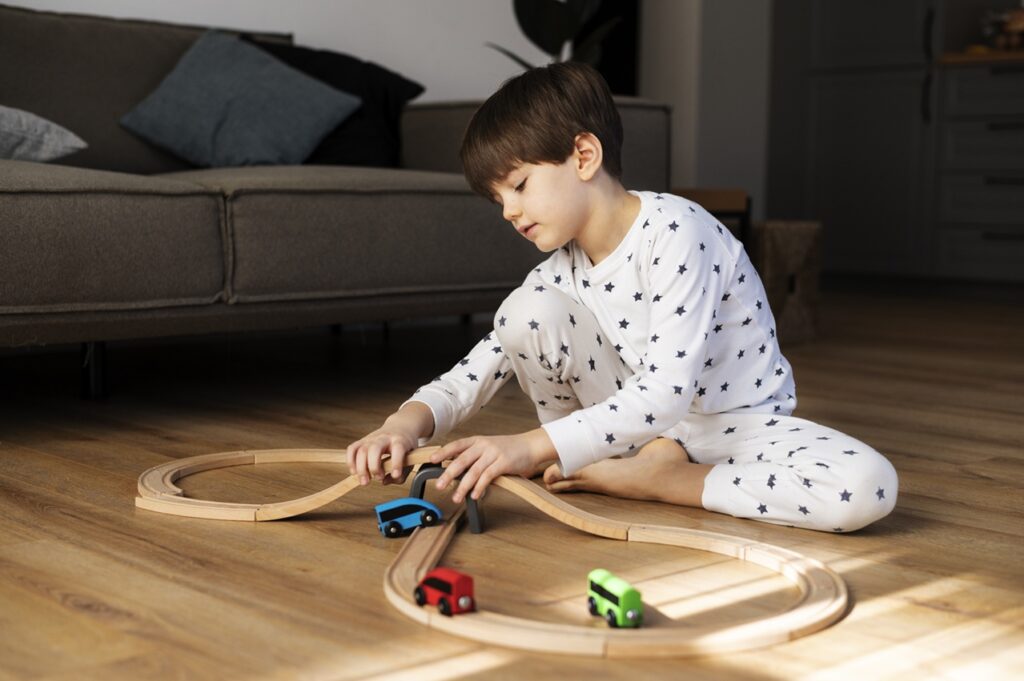Simple & Affordable: Best Toy Rotation Guide for Indian Parents
Too many toys can overwhelm, making homes messy and children restless. Buying more toys isn’t the solution either. Toy rotation—keeping a few toys accessible while storing others—helps make play feel fresh, boosts concentration, and saves money.

How to Use the Best Toy Rotation Guide for Indian Parents Effectively
This guide for Best Toy Rotation Guide for Indian Parents, is based on credible research and current Indian economic data, written in simple English so every parent can implement it easily. Let’s make playtime effective and enjoyable—without needing technical knowledge or extra cost.
Too many toys can overwhelm children and create cluttered homes, leaving kids restless and parents stressed. Buying more toys isn’t the solution. Instead, a simple toy rotation system for Indian parents—where only a few toys are accessible while others are stored—keeps playtime fresh, engaging, and budget-friendly.
This research-backed toy rotation guide in simple English is designed so every parent can reduce clutter, save money, and improve children’s focus without needing technical skills or extra costs. It’s a practical toy rotation strategy for families who want affordable toy organization tips and clutter-free playtime solutions that actually work.
Real Research: Why Fewer Toys Lead to Better Play
A clear study by the University of Toledo found that toddlers offered only four toys played more creatively and stayed engaged longer compared to those with sixteen toys. The children explored each toy deeply rather than jumping around aimlessly UToledo News.
Similarly, a trusted education blog highlights that having fewer toys boosts focus, creativity, and play quality. It recommends showing only three to five toys at a time for toddlers Learning Resources US.
These findings underline the power of simplicity: toy rotation isn’t just clutter control—it nurtures richer, more meaningful play.
Research clearly shows that fewer toys lead to better play experiences for children. A University of Toledo study found that toddlers offered only four toys played more creatively and stayed engaged longer compared to those with sixteen toys. The children explored each toy deeply, improving focus and creativity instead of switching aimlessly.
Similarly, education experts recommend showing only three to five toys at a time for toddlers as part of a simple toy rotation guide for Indian parents. This approach not only boosts child development and learning but also reduces clutter and saves money, making it one of the most affordable toy organization tips for families looking to improve playtime quality without overspending.
Why Now Is Ideal—India’s Low Inflation Landscape
India’s retail inflation hit a significant low in July 2025, dropping to 1.55% year-on-year, the lowest since June 2017 The Times of IndiaReuters. Even more surprisingly, food inflation was negative, at -1.76%, indicating falling prices for everyday staples MoSPIPress Information Bureau.
Additionally, the RBI’s Monetary Policy Committee maintained its neutral stance on September 2025, noting that inflation moderation provides breathing room for consumers and policymakers alike Reuters.
What this means for you: Baseline necessities for toy rotation—like storage boxes or labels—are more affordable now. This is the perfect moment for Indian families to adopt a smart, low-cost system that improves play and organization.
India’s retail inflation dropped to just 1.55% in July 2025, the lowest since June 2017, while food inflation even turned negative at -1.76%, signaling falling prices for essential goods. As the Reserve Bank of India’s Monetary Policy Committee highlighted in September 2025, this low-inflation environment provides families with the perfect opportunity to invest in affordable toy organization systems and budget-friendly toy rotation strategies in India.
With prices for storage boxes, toy bins, and labeling supplies at record lows, this is the best time for Indian parents to set up a cost-effective toy rotation schedule. A simple toy rotation guide with printable trackers helps reduce clutter, save money, and improve children’s focus and creativity — all while staying within budget.

Create Your Own Toy Rotation Tracker
Here’s an easy tracker you can create in Word or Excel and print:
| Date | Toys Out | Toys in Storage | Rotate On |
|---|---|---|---|
| Sep 5 | Blocks, Doll | Cars, Storybooks | Sep 12 |
| Sep 12 | Cars, Puzzles | Blocks, Doll | Sep 19 |
Steps:
- Make a simple 4-column table with headings: Date, Toys Out, Toys in Storage, Rotate On.
- Print it and place it where it’s visible—like on the fridge.
- Update each week when you rotate.
- Use checkboxes or highlights for clarity.
This tracker helps you maintain the habit without any technology or hassle.
Create a printable toy rotation tracker for Indian parents to keep playtime fun and clutter-free:
Date-wise toy rotation schedule: Use a simple 4-column table with headings — Date, Toys Out, Toys in Storage, Rotate On.
Affordable toy organization tips: Print and place the tracker where it’s visible, like on the fridge, for easy access.
Weekly toy rotation habit: Update the tracker each time you rotate toys to maintain a consistent schedule.
Visual toy rotation chart: Add checkboxes or highlights to make tracking effortless.
Step-by-Step Toy Rotation Tracker and Strategy
Gather all toys: Bring everything into one space to see what you have.
Purge gently: Remove broken or unused toys.
Categorize: Sort toys into types like puzzles, building sets, pretend-play.
Use simple storage: Label ordinary boxes or bins for each category.
Select 8–12 toys: Keep a small set active; store the rest.
Set your schedule: Weekly rotations work best—set a reminder on your phone.
Rotate and track: Swap toys and update the tracker to keep things consistent.
Follow this step-by-step toy rotation strategy for Indian parents to make playtime clutter-free and engaging.
Gather all toys for toy rotation: Bring everything into one place so you can plan efficiently.
Purge unused or broken toys: A budget-friendly toy rotation system works best when only quality toys are in rotation.
Categorize toys for easy rotation: Group items into puzzles, building blocks, pretend-play, or educational sets to create a simple toy rotation guide.
Use simple storage solutions for toy organization: Label boxes or bins clearly — an affordable toy organization tip for Indian families.
Select 8–12 toys for active play: A toy rotation schedule for Indian parents ensures kids stay excited without needing new toys.
Set a weekly toy rotation schedule: A research-backed toy rotation tip is to use reminders for consistent swaps.
Rotate and track with a printable toy rotation chart: Maintain your toy rotation system in India easily and ensure long-term success.
Comparison Table of Toy Rotation
| Method | Cost | Ease of Use | Benefit |
|---|---|---|---|
| No Rotation | ₹0 | Hard | Leads to clutter and disengagement |
| DIY Rotation | Very Low | Easy | Organized, fun, budget-friendly |
| Tracker + Rotation | Low | Moderate | Structured, sustained engagement |
Advantages & Disadvantages of Toy Rotation
| Advantages | Disadvantages |
|---|---|
| Reduces clutter and simplifies cleanup | Initial sorting and habit needed |
| Reignites interest in old toys | Requires storage space |
| Saves money by maximizing toy life | Needs routine |
Every system has its Advantages & Disadvantages, and the same goes for a budget-friendly toy rotation system for Indian parents. On the positive side, toy rotation offers many Benefits & Drawbacks to consider. It reduces clutter and simplifies cleanup, helping families stay organized. This simple toy rotation guide in English can reignite interest in old toys, keeping children engaged without spending on new ones. It also saves money by maximizing toy life, making it one of the most affordable toy organization tips for Indian families in 2025.
However, there are some Upsides & Downsides too. Parents might face initial sorting and habit needed for toy rotation, and they may require extra storage space for unused toys. Maintaining a consistent routine for toy rotation is essential for success. Still, the Strengths & Weaknesses clearly show that with research-backed toy rotation tips for meaningful child play, the Gains & Limitations lean heavily in favor of this system, making it a practical, long-term solution for happier, clutter-free homes.
Q1: Can I rotate toys every day?
Yes, but weekly is easier for most families to manage.
Q2: Do I need special software for the tracker?
No, a simple Word or Excel table works perfectly.
Q3: Where should I store the other toys?
Use under-bed boxes, closets, or stackable bins.
Q4: What should I tell my child?
Explain gently: “These toys are taking a rest. They’ll come out soon!”
Q5: What about broken or missing items?
Fix if possible, or donate/replace. Remove from rotation.
Conclusion
Toy rotation is more than a clutter solution—it’s a smart, research-backed way to make play meaningful, focused, and fun. With India’s current low inflation, organizing essentials are accessible, making this system not just practical but timely. This guide, built on credible studies and real-world data, helps you set up toy rotation effortlessly—in simple English, no technology required.
Now is the time: organize your child’s toys, give each piece room to shine, and watch how play transforms. Just copy this content into Rank Math’s Visual Editor, paste it, and you’re good to go.
Best budget-friendly toy rotation ideas for Indian parents can make playtime engaging while saving money. Using research-backed toy rotation tips for meaningful child play ensures that kids stay focused and creative. Parents often ask, how to organize kids’ toys easily without extra cost, and the answer lies in this simple toy rotation guide in plain English for busy parents. A smart toy rotation system to boost creativity and focus is not expensive — in fact, there are plenty of affordable toy organization tips for Indian families in 2025.
Even better, you can set it up without any gadgets using a no-tech toy rotation method to transform playtime at home. Experts recommend practical toy rotation strategies using real-world research to enhance learning outcomes. The child development benefits of a toy rotation system explained in this guide highlight how kids grow smarter with fewer distractions. Finally, how Indian parents can use toy rotation to reduce clutter is the key to a cleaner, happier, and more playful home.












